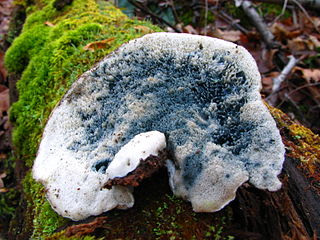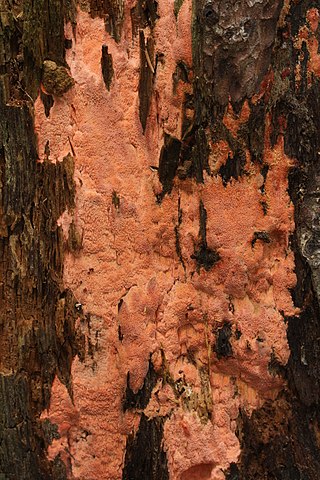
The Polyporaceae are a family of poroid fungi belonging to the Basidiomycota. The flesh of their fruit bodies varies from soft to very tough. Most members of this family have their hymenium in vertical pores on the underside of the caps, but some of them have gills or gill-like structures. Many species are brackets, but others have a definite stipe – for example, Polyporus badius.

The Fomitopsidaceae are a family of fungi in the order Polyporales. Most species are parasitic on woody plants, and tend to cause brown rots. The name comes from Fomitopsis + -aceae.

Erast Parmasto was a noted Estonian mycologist, bioscientist and botanist and onetime director of the Estonian Institute of Zoology and Botany.

Daedaleopsis is a genus of fungi in the family Polyporaceae. The name Daedaleopsis is a reference to Daedalus, the labyrinth-maker of myth. Similarly, the maze-like pattern of pores is taxonomically described as being daedaloid. DNA was recovered and sequenced from fragments of a nearly 7000-year-old fruit body of D. tricolor found in an early Neolithic village in Rome.

Auriporia is a small genus of four species of poroid fungi in the family Fomitopsidaceae.

Parmastomyces is a genus of fungi in the family Fomitopsidaceae. The genus was circumscribed by Czech mycologists František Kotlaba and Zdenek Pouzar in 1964, with Tyromyces kravtzevianus Bondartzev & Parm. as the type species. Parmastomyces species cause a brown rot. The genus has a monomitic hyphal system.

Postia is a genus of brown rot fungi in the family Fomitopsidaceae.

Fomitiporia is a genus of fungi in the family Hymenochaetaceae. According to a 2008 estimate, the widely distributed genus contains 11 species, though three new species were identified in 2010 in sub-Saharan Africa using multigene molecular phylogenetic analysis, and two more were named in a 2013 article. In 2011 it was announced that a specimen of the species F. ellipsoidea was discovered with a fruit body that is largest known of any fungus. However, the species has since been moved to Phellinus.

Haploporus is a genus of poroid fungi in the family Polyporaceae.

Byssomerulius is a widely distributed genus of crust fungi.

Antrodiella is a genus of fungi in the family Steccherinaceae of the order Polyporales.

Irpex is a genus of corticioid fungi in the order Polyporales. Species produce fruit bodies that grow as a crust on the surface of dead hardwoods. The crust features an irpicioid spore-bearing surface, meaning it has irregular and flattened teeth. Irpex is distinguished from the similar genera Junghuhnia and Steccherinum by the simple septa found in the generative hyphae.

Aurantiporus is a genus of poroid fungi in the family Meruliaceae. Circumscribed by American mycologist William Alphonso Murrill in 1905, the genus contains five species found mostly in northern temperate regions. Molecular analysis of several Aurantiporus species suggests that the genus is not monophyletic, but some other related polypore species need to be sequenced and studied before appropriate taxonomic changes can be made. In 2018, Viktor Papp and Bálint Dima proposed a new genus Odoria to contain Aurantiporus alborubescens based on multigene phylogenetic analyses. The generic name is derived from the Latin aurantius ("orange") and the Ancient Greek πόρος (pore).

Oligoporus is a genus of fungi in the family Polyporaceae. The genus was circumscribed by German mycologist Julius Oscar Brefeld in 1888 with Oligoporus farinosus as the type. This species is currently known as Postia rennyi. The genus name combines the Ancient Greek words ὀλίγος ("few") and πόρος ("pore").
Piloporia is a genus of two species of poroid fungi in the family Polyporaceae. The genus was circumscribed by Finnish mycologist Tuomo Niemelä in 1982, with P. sajanensis as the type species. The Indian species P. indica was added to the genus in 1988. P. sajanensis is found in Asia and Europe. In Asia, it is usually recorded on spruce, fir, and larch, while in Europe it is commonly found on spruce, but also on pine. Piloporia species cause a white rot in conifers and hardwoods.

Skeletocutis is a genus of about 40 species of poroid fungi in the family Polyporaceae. The genus has a cosmopolitan distribution, although most species are found in the Northern Hemisphere. It causes a white rot in a diverse array of woody substrates, and the fruit bodies grow as a crust on the surface of the decaying wood. Sometimes the edges of the crust are turned outward to form rudimentary bracket-like caps.
Kari Korhonen is a Finnish mycologist and forest pathologist, known for his studies of fungi causing root rot.

Inocutis is a genus of nine species of polypore fungi in the family Hymenochaetaceae.

Rhodonia is a genus of fungal crust fungi in the family Fomitopsidaceae. The species in the genus are species of brown rot, found in China, Europe, and North America, where it grows on decaying conifer wood.

Anthoporia is a fungal genus in the family Meripilaceae. It is a monotypic genus, circumscribed in 2016 to contain the single species Anthoporia albobrunnea.


















